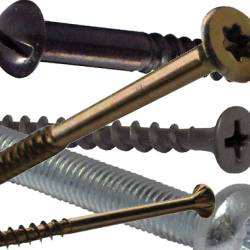What Types Of Screws And Fixings Are There?
Screws and fixings are used for a variety of purposes, usually to hold and secure items together or to attach them to walls, floors or roofs. They can also be used in combination to provide a secondary form of security. The suitability of a screw or fixing for a particular job depends largely on the base material you are working with. However, there are still subtle differences between the types of screws and fixings available, which allow you to select the most suitable screw or fixing for the job in hand.
In this guide we are attempting to explain the different types of screw and fixings and also what they are most typically used for.
Nails

Nails are a very traditional type of fixing and are quite basic in their design. They have a head and a pointed shaft, which allows them to be hammered into position to hold two materials together, usually wood. They are basic but effective. However, unlike screws they don’t have a thread, and hence any pull force along the same axis as a nail will pull it out of position. Nails are differentiated by the material they are made from, the type of head and the type of material they are suitable for.
Different types of nail include:
- Bright nails
- Galvanised nails
- Masonry nails
- Panel pins
- Roofing nails
- Tacks
Screws
Screws are different to nails because they need a screwdriver to insert and fix them. They have various different types of head, which dictates which screwdriver you should use, such as Phillips head, flathead/slotted, Hex (Allen key or socket head), Torx, Robertson (scrulox) or countersunk. Screws are also made from different materials, usually mild steel, stainless steel or brass, but can also be plated in zinc, chrome or brass. Screws are more effective and flexible than nails in that they provide a better clamping force and can be removed easily by reversing the thread. Screws are differentiated also by their length and diameter.
Different types of screw include:
- Woodscrews – with a smooth shank and tapered point for screwing into wood
- Drywall screws – the whole length is threaded to allow them to screw into more delicate plasterboard or drywall
- Self-tapping screws – these screws have a variety of uses and allow you to create your own hole in the base material
- Masonry screws – specifically for screwing into masonry
- Security screws – for areas of high risk of vandalism or theft, here the screw can be fixed one way and then can’t be reversed without using a special tool, and hence can’t be tampered with
- Machine screws – these have a blunt end and a thread to fasten metal parts together on a machine. They are resistant to loosening through vibration
Fixings
Fixings are a variety of other designs used to secure materials in place, often in combination with another type of fixing. A typical example is a wall/rawl plug which is a moulded plastic accessory which is located in a hole in a masonry or brick wall and holds a screw more tightly when the screw is secured inside it. Also, hook & eye fixings have a thread that is screwed into a wall but has a hook which allows an item to be secured and attached with it, such as rope, chain or cable.
Different types of fixings include:
- Wall/rawl plugs
- Frame and anchor fixings
- Heavy duty fixings
- Hook & eye fixings
- Plasterboard fixings
- Cavity fixings
Nuts and bolts
These are a type of two-piece fastener used to hold materials together. A threaded bolt is inserted into a hole and through the centre of the nut already in place. The bolt is then screwed over the top of the nut to secure it. Where there is expected to be lots of movement and potential loosening, a washer may also be inserted underneath the nut, which makes the fixing more stable and resistant to loosening.
How to decide on the right type of fixing
When choosing the right type of screw or fixing you obviously need to consider the size and length that you need, but also the base materials you are working with. So you need to find an option that is suitable for the material combination, ie. attaching two metals or metal to wood, or for what you are screwing into, ie. wood, metal, masonry, drywall or roofing materials.
In addition, you may also want to consider these factors:
- The cost of the screws and fixings
- The potential damage you could cause by doing the job incorrectly
- Health and safety implications of choosing the wrong type of screw or fixing
- How easy the item is to work with and install
- The load rating of the screw or fixing, ie. what kind of weights is it safe to hold?